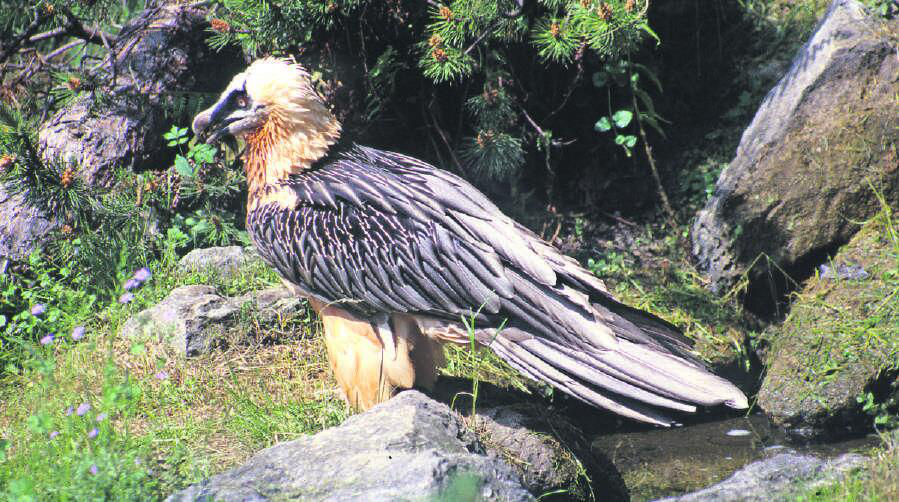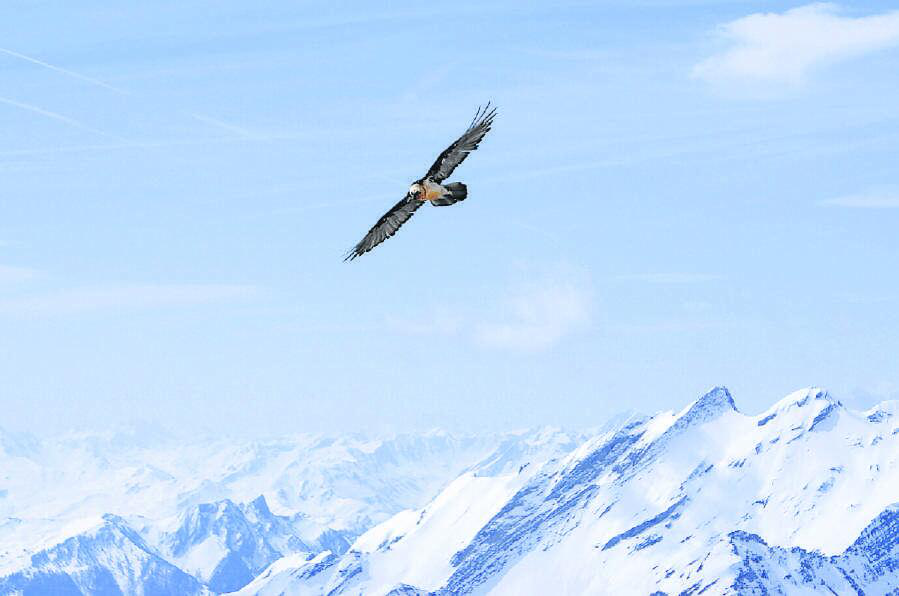Switzerland’s largest breeding birds in the Saanenland, Part 2
17.08.2021 Gstaad LivingHow privileged we are to be able to observe Switzerland’s two largest breeding birds, the golden eagle and the bearded vulture, here in Saanenland. When one of these imposing birds is circling in the azure sky above the highest mountain peaks, not only the ornithologist’s heart begins to beat faster, but also that of mountaineers and hikers.
A group of committed conservationists and ornithologists successfully reintroduced the bearded vulture in the Alps after it had been extinct. Around 1800, this majestic giant bird circled peacefully above the highest mountain peaks and Alpine pastures until sheep farmers, Alpine shepherds and hunters began to shoot it.
They did so for the bounty of shot and due to the ignorance of the time: they believed that the lammergeier, as it used to be called, would rob them of sheep and even small children. The last known shooting dates back to 1913, when an adult bird was shot in the nearby Aosta Valley.
When bearded vultures started breeding in 1973 in the Alpine Zoo in Innsbruck, the idea was born to reintroduce them to the Alps. And so began the reintroduction project for bearded vultures. Other zoos and animal parks in Switzerland and abroad began to participate, including the Goldau Zoo, where several young birds had already been bred in the meantime.
From 1986 onwards, offspring was successfully released into the wild every year throughout the Alpine region, first in the Austrian Hohe Tauern National Park, then in the Savoy Alps and in 1991 for the first time in the Engadine.
To observe and control the birds released into the wild, some of them received GPS transmitters, and individual feathers were bleached with hydrogen peroxide paste, so they could easily be recognised in flight. To the delight of the initiators, 22 breeding territories were known in Switzerland by 2020.
So far, 36 young birds have hatched in the wild in the entire Alpine region (Switzerland, France, Austria and Italy). One of them hatched only last year in the western Bernese Oberland! As with the golden eagle, the exact locations of breeding places remain undisclosed for reasons of protection.
Occurrence and size
Bearded vultures have since been spotted throughout the Alps between 1600 and 3000 metres above sea level. In the Saanenland, they often roam around the Gummfluh and Rellerli-Hugeligrat areas, as they have vast territories that can cover up to 350 square kilometres. The best chance of seeing the giant bird at close quarters is on Glacier 3000 at the Refuge near the Quille du Diable. Around midday, the birds rise from the Derborence in a thermal, where there has been an eyrie in the immediate vicinity for several years.
Adult bearded vultures reach an enormous wingspan of up to 1.9 metres and a weight of 5 to 7 kilograms.
Food
Bearded vultures feed to 80 per cent on bones, which they take from animals that have been killed in accidents or by eagles, whose carcasses keep lying around. With this, they act as a kind of health police and help prevent the spread of diseases.
They can swallow bone pieces of up to 18 centimetres, which are then decomposed and digested by aggressive gastric juices. They carry larger bones up to 50 metres in the air in their jaws and then drop them onto rock slabs, where the bones splinter into edible junks. This behaviour gave the bearded vulture its Spanish nickname, Quebrantahuesos, which translates as bone crusher.
Young birds are fed chiefly on meat during the rearing phase. Bearded vultures are, therefore, not birds of prey like eagles and falcons. Moreover, their claws are so flat, they could not even strike live prey or carry it away.
Breeding
Bearded vulture pairs start building their nests in autumn. They can reach huge dimensions after several years of use. Some are up to 2.5 metres wide and 1.6 metres high. The cavity of the eyrie is well padded with sheep’s wool and similar insulating material as the birds begin to lay their eggs – there are usually two eggs – as early as December or January.
The laying interval from the first to the second egg is about one week, so that, as in the case of the golden eagle, siblicide often often takes place, and only one young bird survives. The breeding period is about 55 days. The nestlings fly out around mid-March after 120 days, which is ideal for providing food for the adults, as in many places avalanche victims such as chamois and ibexes appear in the melting snow.
The roughly 300 bearded vultures that live in the entire Alpine region are strictly protected.
BASED ON AVS/BERT INÄBNIT






